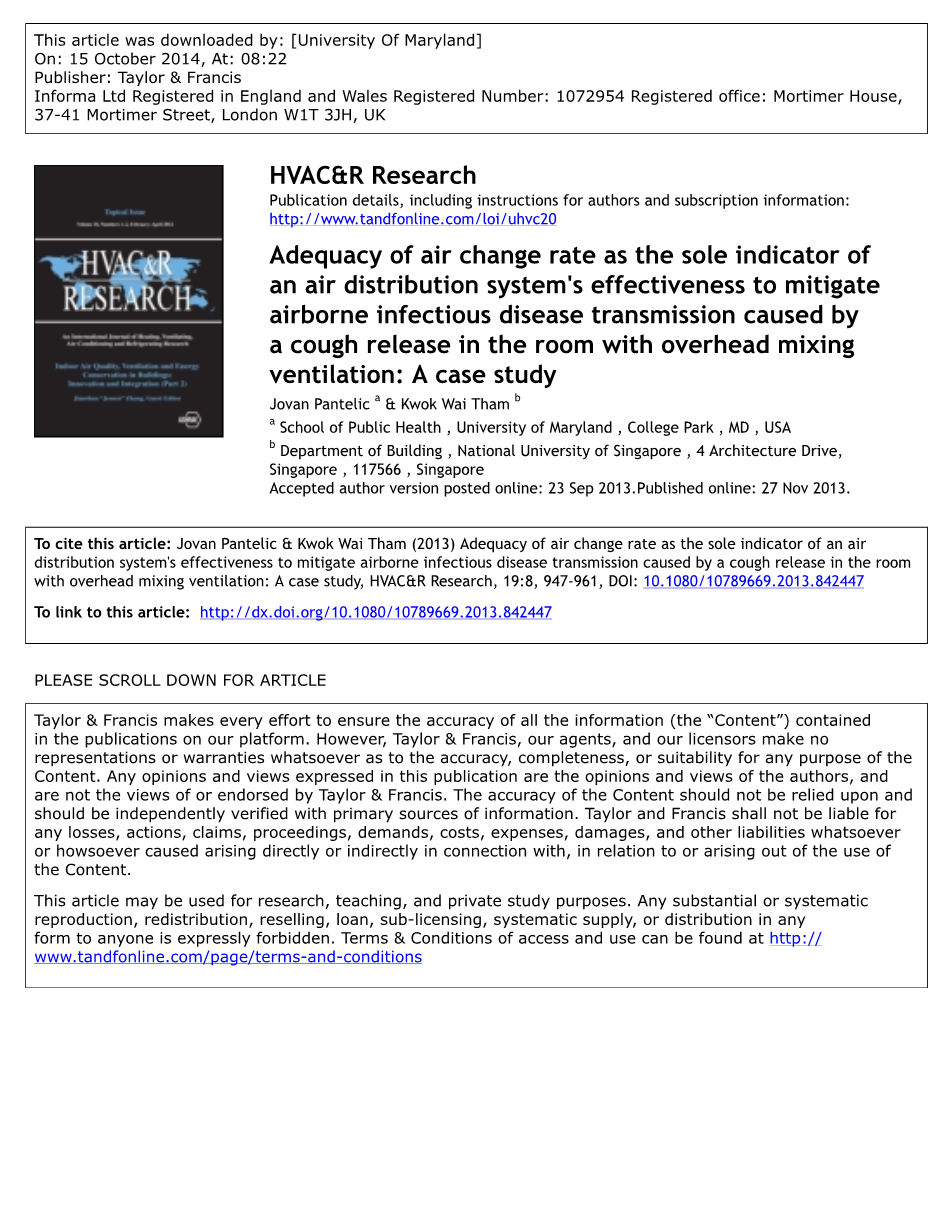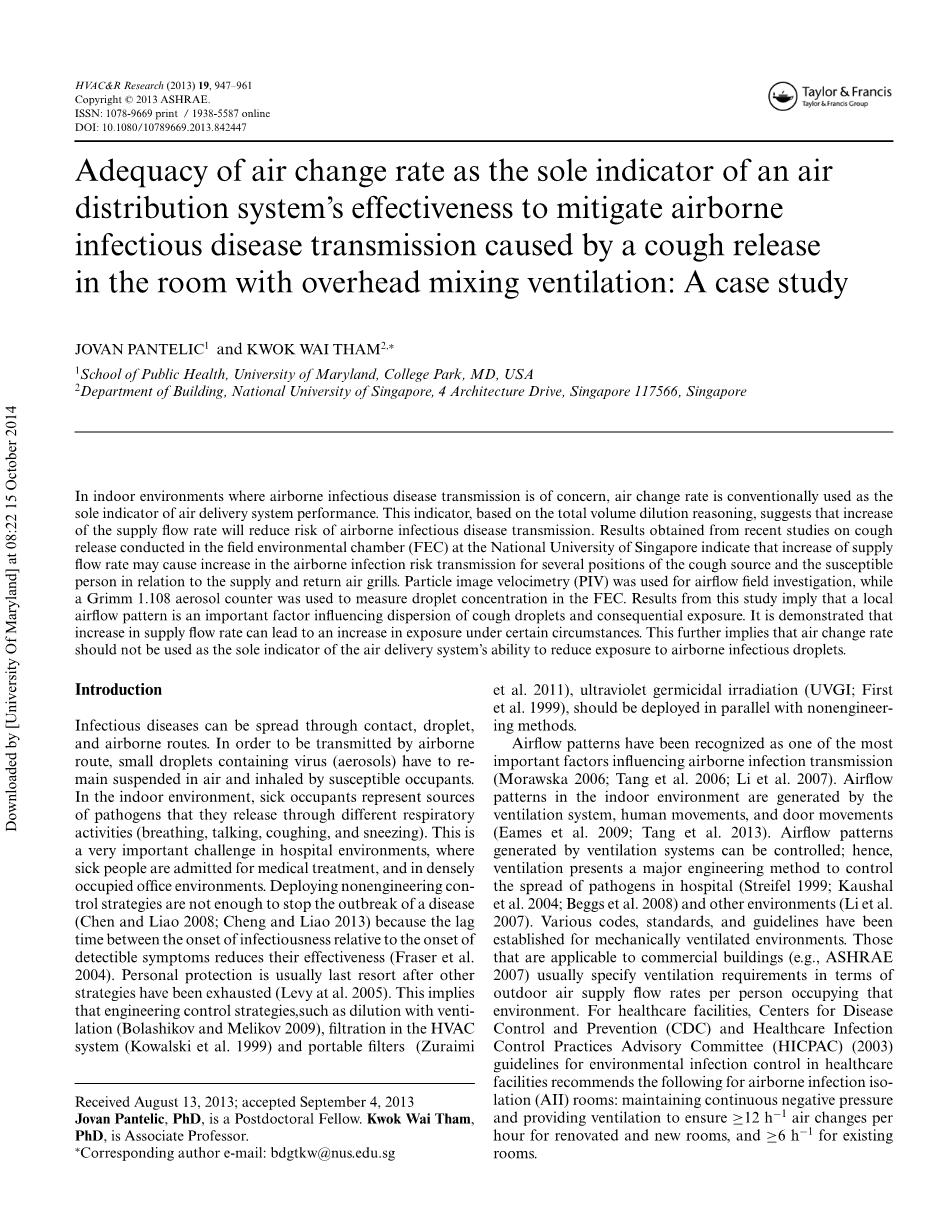英语原文共 16 页,剩余内容已隐藏,支付完成后下载完整资料
Adequacy of air change rate as the sole indicator of an air distribution systems effectiveness to mitigate airborne infectious disease transmission caused by a cough release in the room with overhead mixing ventilation: A case study
以空气置换率作为单一指标评估顶送式混合通风对咳嗽造成传染病空气传播效率的研究:案例分析。
In indoor environments where airborne infectious disease transmission is of concern, air change rate is conventionally used as the sole indicator of air delivery system performance. This indicator, based on the total volume dilution reasoning, suggests that increase of the supply flow rate will reduce risk of airborne infectious disease transmission. Results obtained from recent studies on cough release conducted in the field environmental chamber (FEC) at the National University of Singapore indicate that increase of supply flow rate may cause increase in the airborne infection risk transmission for several positions of the cough source and the susceptible person in relation to the supply and return air grills. Particle image velocimetry (PIV) was used for airflow field investigation, while a Grimm 1.108 aerosol counter was used to measure droplet concentration in the FEC. Results from this study imply that a local airflow pattern is an important factor influencing dispersion of cough droplets and consequential exposure. It is demonstrated that increase in supply flow rate can lead to an increase in exposure under certain circumstances. This further implies that air change rate should not be used as the sole indicator of the air delivery systemrsquo;s ability to reduce exposure to airborne infectious droplets.
室内环境中,空气传染病的传播受到关注。空气交换率通常被用作评价空气疏运系统性能的单一指标。此指标基总体积稀释理论,说明空气供应量的增加将减少空气传染病的传播几率。新加坡国立大学最近实施的关于场场环境内咳嗽释放的研究结果表明,供气量的增加可能导致一些咳嗽源处或与供回空气格栅有关的易感人群的空气传染病的传播风险的增加。粒子图像测速应用于气流流场的调查,而格林1.018溶胶计数器用于测量场环境室内的液滴浓度。这项研究的结果表明,局部气流模式是影响咳嗽液滴分布以及相对暴露程度的重要因素。有证据表明,在某些情况下,供气量的增加会引起暴露水平的增加。这进一步表明,通风换气次数不应当被当做空气输运系统减少(人们)对于空气传染液滴的接触的能力的唯一指标。
Infectious diseases can be spread through contact, droplet,and airborne routes. In order to be transmitted by airborne route, small droplets containing virus (aerosols) have to remain suspended in air and inhaled by susceptible occupants. In the indoor environment, sick occupants represent sources of pathogens that they release through different respiratory activities (breathing, talking, coughing, and sneezing). This is a very important challenge in hospital environments, where sick people are admitted for medical treatment, and in densely
occupied office environments. Deploying non-engineering control strategies are not enough to stop the outbreak of a disease(Chen and Liao 2008; Cheng and Liao 2013) because the lag time between the onset of infectiousness relative to the onset of detectable symptoms reduces their effectiveness (Fraser et al. 2004). Personal protection is usually last resort after other strategies have been exhausted (Levy at al. 2005). This implies that engineering control strategies,such as dilution with ventilation (Bolashikov and Melikov 2009), filtration in the HVAC system (Kowalski et al. 1999) and portable filters (Zuraimi et al. 2011), ultraviolet germicidal irradiation (UVGI; First
et al. 1999), should be deployed in parallel with non-engineering methods
传染病可以通过接触、飞沫和空气途径传播。含有病毒的沫只有保持悬浮在空气中,并且被易感人群吸入才可以通过气流传播。在室内环境中,病人代表着他们通过不同呼吸活动所释放的病原体的源头。这对于病人接受医学治疗的医院环境和人员密集的办公环境来说是一个重要的挑战。采用非工程控制策略不足以阻止疾病的爆发,因为从传染性开始到可检测症状之间的滞后时间降低了它的有效性。个人防护通常是其他策略用尽之后的最后手段。这意味着一些工程控制策略比如通风系统稀释、暖通空调系统过滤、便携式过滤、紫外辐射杀菌,应该与非工程方法平行展开。
Airflow patterns have been recognized as one of the most important factors influencing airborne infection transmission (Morawska 2006; Tang et al. 2006; Li et al. 2007). Airflow patterns in the indoor environment are generated by the ventilation system, human movements, and door movements (Eames et al. 2009; Tang et al. 2013). Airflow patterns generated by ventilation systems can be controlled; hence, ventilation presents a major engineering method to control the spread of pathogens in hospital (Streifel 1999; Kaushal et al. 2004; Beggs et al. 2008) and other environments (Li et al.2007). Various codes, standards, and guidelines have been established for mechanically ventilated environments. Those that are applicable to commercial buildings (e.g., ASHRAE 2007) usually specify ventilation requirements in terms of outdoor air supply flow rates per person occupying that environment. For healthcare facilities, Centers for Disease Control and Prevention (CDC) and Healthcare Infection Control Practices Advisory Committee (HICPAC) (2003)
guidelines for environmental infection control in healthcare facilities recommends the following for airborne infection isolation (AII) rooms: maintaining continuous negative pressure and providing ventilation to ensure ge;12 hminus;1 air changes per hour for renovated and new rooms, and ge;6 hminus;1 for existing rooms.
气流模式被认为是影响空气传染病传播的最重要因素之一。室内环境的气流模式,产自于通风系统、人的移动以及门的运动。通风系统产生的气流模式是可控的,因此通风系统代表了控制医院和其他环境的病原体传播的一种主要工程方法。人们为机械通风环境出台的各种法则、标准和指南。用于商业建筑的这些标准通常依据每个人在该环境下占据的室外空气供应量来指定通风设备。对于医疗设施,疾病控制,预防中心和医疗感染控制食物咨询委员会的指导方针对于医疗设施中的环境感染控制对于空气传染隔离病房的要求如下:保持持续负压,并且对于翻修和新建的房间保证大于每小时12次的空气交换量,或对于已存在的房间保证大于每小时6次的空气交换量。
Several studies (e.g., Qian et al. 2006; Nielsen et al, 2010; Qian and L, 2010) utilizing tracer gas as a surrogate for exhaled pathogens suggested that increasing supply flow rate reduces exposure of the occupants and therefore risk of crossinfection. Results from these studies confirm that specification in guidelines (e.g., AII rooms [CDC and HICPAC 2003]) based on the air change rate are appropriate because increasing the air change rate will diminish the risk of airborne infectious disease transmission through dilution of pathogen concentration. In a study of a hospital patient room Bolashikov et al. (2012) reported that in one of the investigated scenarios, contrary to expectations, peak concentration level (PCL) of coughed CO2 at 12 hminus;1 was much higher compa
剩余内容已隐藏,支付完成后下载完整资料
资料编号:[239036],资料为PDF文档或Word文档,PDF文档可免费转换为Word
以上是毕业论文外文翻译,课题毕业论文、任务书、文献综述、开题报告、程序设计、图纸设计等资料可联系客服协助查找。




